本节引言
本节开始讲 Android 中的布局,今天我们要讲解的就是第一个布局,LinearLayout(线性布局),我们屏幕适配的使用用的比较多的就是 LinearLayout 的 weight(权重属性),在这一节里,我们会详细地解析 LinearLayout,包括一些基本的属性,Weight 属性的使用,以及比例如何计算,另外还会说下一个用的比较少的属性:android:divider 绘制下划线!
1.本节学习图
2.weight(权重)属性详解
①最简单用法
如图:
实现代码:
<LinearLayout xmlns:android="http://schemas.android.com/apk/res/android" xmlns:tools="http://schemas.android.com/tools" android:id="@+id/LinearLayout1" android:layout_width="match_parent" android:layout_height="match_parent" android:orientation="horizontal"> <LinearLayout android:layout_width="0dp" android:layout_height="fill_parent" android:background="#ADFF2F" android:layout_weight="1"/> <LinearLayout android:layout_width="0dp" android:layout_height="fill_parent" android:background="#DA70D6" android:layout_weight="2"/> </LinearLayout>
复制代码
要实现第一个的 1:1 的效果,只需要分别把两个 LinearLayout 的 weight 改成 1 和 1 就可以了用法归纳:按比例划分水平方向:将涉及到的 View 的 android:width 属性设置为 0dp,然后设置为 androidweight 属性设置比例即可;类推,竖直方向,只需设 android:height 为 0dp,然后设 weight 属性即可!大家可以自己写个竖直方向的等比例划分的体验下简单用法!
②weight 属性详解
当然,如果我们不适用上述那种设置为 0dp 的方式,直接用 wrap_content 和 match_parent 的话,则要接着解析 weight 属性了,分为两种情况,wrap_content 与 match_parent!另外还要看 LinearLayout 的 orientation 是水平还是竖直,这个决定哪个方向等比例划分
1)wrap_content 比较简单,直接就按比例的了
实现代码:
<LinearLayout xmlns:android="http://schemas.android.com/apk/res/android" xmlns:tools="http://schemas.android.com/tools" android:id="@+id/LinearLayout1" android:layout_width="match_parent" android:layout_height="match_parent" android:orientation="horizontal" > <TextView android:layout_weight="1" android:layout_width="wrap_content" android:layout_height="fill_parent" android:text="one" android:background="#98FB98" /> <TextView android:layout_weight="2" android:layout_width="wrap_content" android:layout_height="fill_parent" android:text="two" android:background="#FFFF00" /> <TextView android:layout_weight="3" android:layout_width="wrap_content" android:layout_height="fill_parent" android:text="three" android:background="#FF00FF" /> </LinearLayout>
复制代码
2)match_parent(fill_parent):这个则需要计算了
我们写这段简单的代码:
<LinearLayout xmlns:android="http://schemas.android.com/apk/res/android" xmlns:tools="http://schemas.android.com/tools" android:id="@+id/LinearLayout1" android:layout_width="match_parent" android:layout_height="match_parent" > <TextView android:layout_weight="1" android:layout_width="fill_parent" android:layout_height="fill_parent" android:text="one" android:background="#98FB98" /> <TextView android:layout_weight="2" android:layout_width="fill_parent" android:layout_height="fill_parent" android:text="two" android:background="#FFFF00" /> <TextView android:layout_weight="3" android:layout_width="fill_parent" android:layout_height="fill_parent" android:text="three" android:background="#FF00FF" /> </LinearLayout>
复制代码
运行效果图:
这个时候就会有疑问了,怎么会这样,这比例是 2:1 吧,那么 three 去哪了?代码里面明明有 three 的啊,还设置了 3,而 1 和 2 的比例也不对耶,1:2:3 却变成了 2:1:0,怎么会这样呢?
答:这里其实没那么简单的,还是需要我们计算的,网上给出的算法有几种,这里就给出觉得比较容易理解的一种:
step 1:个个都是 fill_parent,但是屏幕只有一个啦,那么 1 - 3 = - 2 fill_parent
step 2:依次比例是 1/6,2/6,3/6
step 3:先到先得,先分给 one,计算: 1 - 2 * (1/6) = 2/3 fill_parent 接着到 two,计算: 1 - 2 * (2/6) = 1/3 fill_parent 最后到 three,计算 1 - 2 * (3/6) = 0 fill_parent
step 4:所以最后的结果是:one 占了两份,two 占了一份,three 什么都木有以上就是为什么 three 没有出现的原因了。
或许大家看完还是有点蒙,没事,我们举多几个例子试试就知道了!
比例为:1:1:1
按照上面的计算方法算一次,结果是:1/3 1/3 1/3,没错
接着我们再试下:2:3:4
计算结果:5/9 3/9 1/9,对比效果图,5:3:1,也没错,所以这个计算方法你可得 mark 下了!
③Java 代码中设置 weight 属性
setLayoutParams(new LayoutParams(LayoutParams.FILL_PARENT, LayoutParams.WRAP_CONTENT, 1));
复制代码
3.为 LinearLayout 设置分割线
很多界面开发中都会设置一些下划线,或者分割线,从而使得界面更加整洁美观,比如下面的酷狗音乐的注册页面:
对于这种线,我们通常的做法有两种
①直接在布局中添加一个 view,这个 view 的作用仅仅是显示出一条线,代码也很简单:
<View android:layout_width="match_parent" android:layout_height="1px" android:background="#000000" />
复制代码
这个是水平方向上的黑线,当然你也可以改成其他颜色,或者使用图片
②第二种则是使用 LinearLayout 的一个 divider 属性
直接为 LinearLayout 设置分割线这里就需要你自己准备一张线的图片了 1)android:divider 设置作为分割线的图片 2)android:showDividers 设置分割线的位置,none(无),beginning(开始),end(结束),middle(每两个组件间)3)dividerPadding 设置分割线的 Padding
使用示例:
实现代码:
<LinearLayout xmlns:android="http://schemas.android.com/apk/res/android" xmlns:tools="http://schemas.android.com/tools" android:id="@+id/LinearLayout1" android:layout_width="match_parent" android:layout_height="match_parent" android:divider="@drawable/ktv_line_div" android:orientation="vertical" android:showDividers="middle" android:dividerPadding="10dp" tools:context="com.jay.example.linearlayoutdemo.MainActivity" > <Button android:layout_width="wrap_content" android:layout_height="wrap_content" android:text="按钮1" /> <Button android:layout_width="wrap_content" android:layout_height="wrap_content" android:text="按钮2" /> <Button android:layout_width="wrap_content" android:layout_height="wrap_content" android:text="按钮3" /> </LinearLayout>
复制代码
4.LinearLayout 的简单例子
实现代码如下:
<LinearLayout xmlns:android="http://schemas.android.com/apk/res/android" xmlns:tools="http://schemas.android.com/tools" android:id="@+id/LinearLayout1" android:layout_width="fill_parent" android:layout_height="fill_parent" android:orientation="vertical" tools:context=".MainActivity" > <TextView android:layout_width="wrap_content" android:layout_height="wrap_content" android:text="请输入要保存的电话号码"/> <EditText android:layout_width="fill_parent" android:layout_height="wrap_content"/> <LinearLayout android:layout_width="fill_parent" android:layout_height="wrap_content" android:orientation="horizontal" android:gravity="right"> <Button android:layout_width="wrap_content" android:layout_height="wrap_content" android:text="保存"/> <Button android:layout_width="wrap_content" android:layout_height="wrap_content" android:text="清空"/> </LinearLayout> </LinearLayout>
复制代码
5.注意事项:
使用 Layout_gravity 的一个很重要的问题!!!问题内容:在一个 LinearLayout 的水平方向中布置两个 TextView,想让一个左,一个右,怎么搞?或许你会脱口而出:"gravity 设置一个 left,一个 right 就可以啦!"真的这么简单?你试过吗?代码如下:
<LinearLayout xmlns:android="http://schemas.android.com/apk/res/android" xmlns:tools="http://schemas.android.com/tools" android:layout_width="match_parent" android:layout_height="match_parent" android:orientation="horizontal" tools:context="com.jay.example.getscreendemo.MainActivity" > <TextView android:layout_width="wrap_content" android:layout_height="200dp" android:layout_gravity="left" android:background="#FF7878" android:gravity="center" android:text="O(∩_∩)O哈哈~" /> <TextView android:layout_width="wrap_content" android:layout_height="200dp" android:layout_gravity="right" android:background="#FF7428" android:gravity="center" android:text="(*^__^*) 嘻嘻……" /> </LinearLayout>
复制代码
运行结果图:
看到这里你会说:哎呀,真的不行耶,要不在外层 LinearLayout 加个 gravity=left 的属性,然后设置第二个 TextView 的 layout_gravity 为 right,好我们试一下:
<LinearLayout xmlns:android="http://schemas.android.com/apk/res/android" xmlns:tools="http://schemas.android.com/tools" android:layout_width="match_parent" android:layout_height="match_parent" android:orientation="horizontal" android:gravity="left" tools:context="com.jay.example.getscreendemo.MainActivity" > <TextView android:layout_width="wrap_content" android:layout_height="200dp" android:background="#FF7878" android:gravity="center" android:text="O(∩_∩)O哈哈~" /> <TextView android:layout_width="wrap_content" android:layout_height="200dp" android:layout_gravity="right" android:background="#FF7428" android:gravity="center" android:text="(*^__^*) 嘻嘻……" /> </LinearLayout>
复制代码
结果还是一样:
当 android:orientation="vertical" 时, 只有水平方向的设置才起作用,垂直方向的设置不起作用。即:left,right,center_horizontal 是生效的。当 android:orientation="horizontal" 时, 只有垂直方向的设置才起作用,水平方向的设置不起作用。即:top,bottom,center_vertical 是生效的。
然而,这方法好像并没有什么太大作用。比如:如果只能竖直方向设置左右对齐的话,就会出现下面的效果:
这显然不是我们要的结果。综上,要么按照上述给出的规则来布局,不过对于这种情况还是使用相对布局 RelativeLayout 把!网上没给出具体的原因,都是说这样改有人说这个和 orientation 的优先级有关,暂且先 mark 下来吧,后续如果知道原因的话再解释!前面屏幕适配也说过了,布局还是建议使用 RelativeLayout!
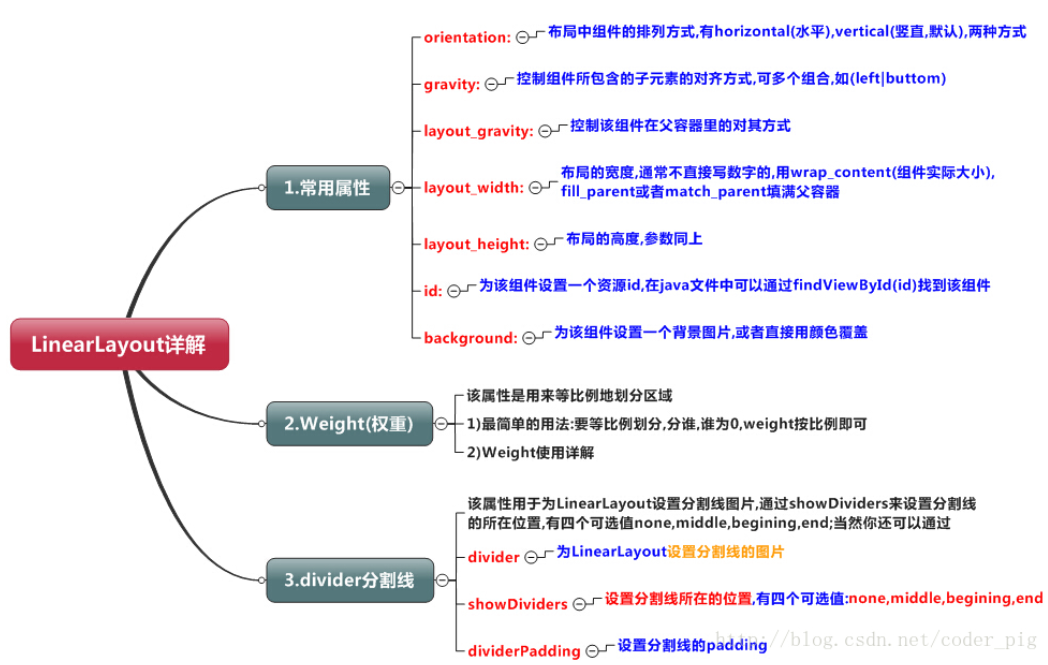
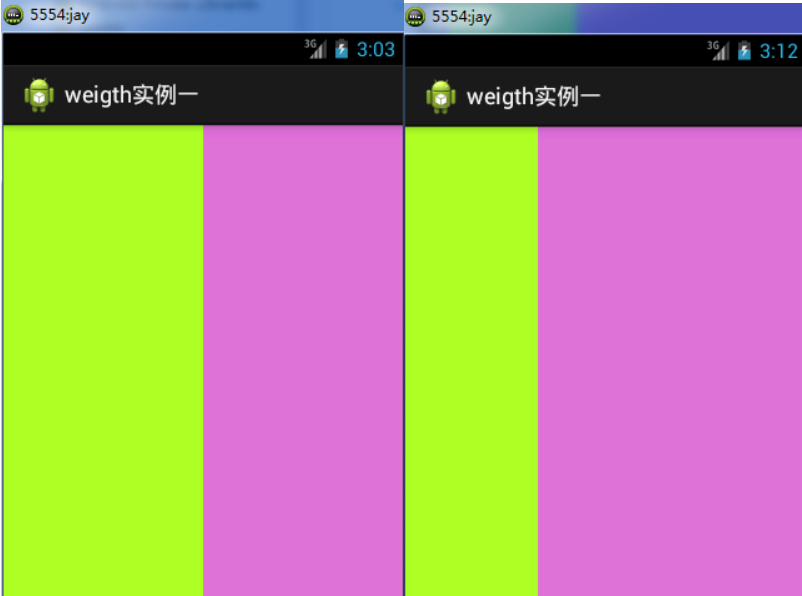

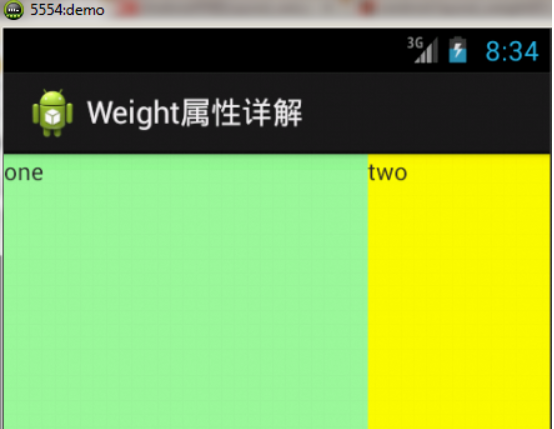
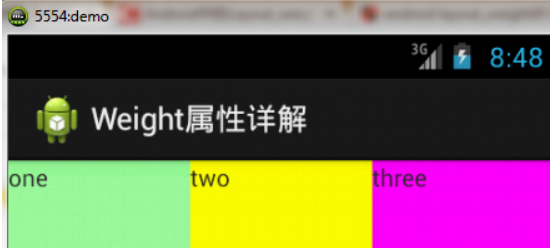
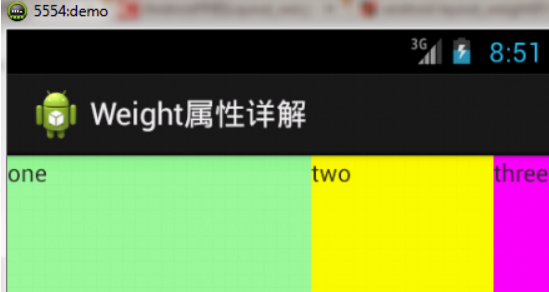

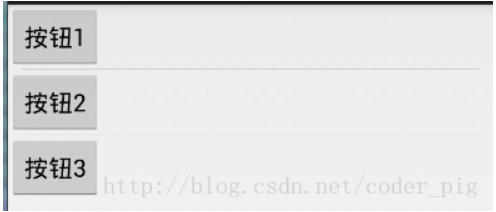
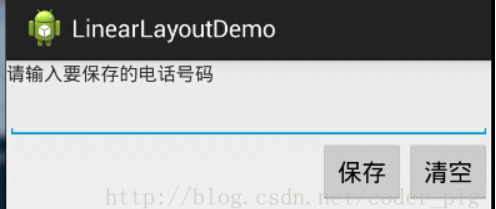
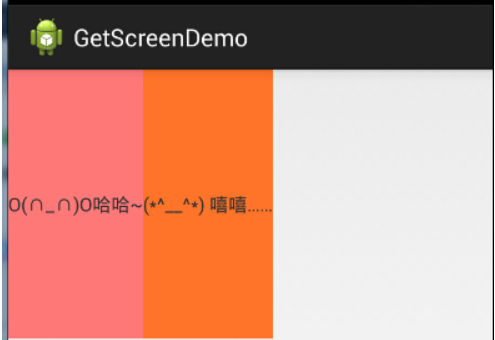
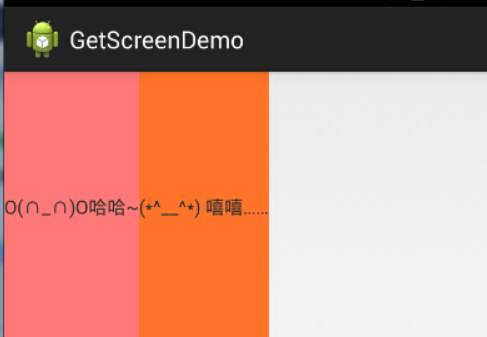












评论